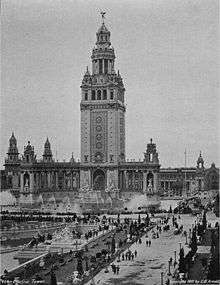John Galen Howard
| John Galen Howard | |
|---|---|
 John Galen Howard in 1886 | |
| Born |
May 8, 1864 Chelmsford, Massachusetts |
| Died |
July 18, 1931 (aged 67) San Francisco, California |
| Alma mater | Massachusetts Institute of Technology |
| Occupation | Architect |
| Awards | Fellow of the American Institute of Architects (1901) |
| Practice | Howard, Cauldwell & Morgan |
| Projects | University of California, Berkeley, School of Architecture |
John Galen Howard (May 8, 1864 in Chelmsford, Massachusetts – July 18, 1931 in San Francisco, California) was an American architect who began his career in New York before moving to San Francisco, California. He was the principal architect at Howard, Cauldwell & Morgan and employed Julia Morgan early in her architectural career.
Howard was educated at the Massachusetts Institute of Technology (1882-1885) and the École des Beaux-Arts(1891-1893). He was an apprentice with H. H. Richardson and then a draftsman with Shepley, Rutan & Coolidge.
Howard completed many notable projects and was elected a Fellow in the American Institute of Architects in 1901.[1]
Career
After practicing in New York, Howard moved to California in 1901 to execute the Hearst Plan as the supervising architect of the Master Plan for the University of California, Berkeley campus, and for founding the University of California's architecture program. Among his most famous buildings are the Campanile, California Memorial Stadium, Sather Gate, and the Hearst Greek Theatre, all located at UC Berkeley.

Howard also designed the centerpiece of the 1901 Pan-American Exposition, the Electric Tower,[2] several buildings at the Alaska–Yukon–Pacific Exposition in Seattle, and the San Francisco Civic Auditorium.
Some of his works are listed on the U.S. National Register of Historic Places (NRHP).[3][4]
In 1910 he was elected into the National Academy of Design as an Associate Academician.
Personal
John Galen Howard born May 8, 1864 in Chelmsford, MA. Howard was son of physician, Dr. Levi Howard and Lydia Jane Hapgood, a homemaker and he had four brothers.[5] He married Mary Robertson Bradbury on August 1, 1893.[5] They had five children; Henry Temple Howard (born in 1894) was an architect who worked with his father; Robert Boardman Howard (born 1896), became a sculptor and married another noted Bay Area sculptor, Adaline Kent (1900-1957); other children included Charles Houghton Howard (born 1899), John Langley Howard (born 1902) both were known artists of the time, and Jeanette Howard (born 1905).[5]
Works
- California Hall, Berkeley, CA, NRHP-listed
- California Memorial Stadium, Bet. Piedmont Ave., Stadium Rim Way, Cannyon Rd., Bancroft Way and Prospect St., Berkeley, CA, NRHP-listed
- Cloyne Court Hotel, 2600 Ridge Rd., Berkeley, CA, NRHP-listed
- Doe Memorial Library, Berkeley, CA, NRHP-listed
- Drawing Building, Hearst Ave., University of California campus, Berkeley, CA, NRHP-listed
- Durant Hall, Berkeley, CA, NRHP-listed
- Electric Tower, Buffalo, NY, Destroyed shortly after the Pan-American Exposition.
- First Congregational Church, Oakland, CA
- Haviland Hall, University of California Campus, Berkeley, CA, NRHP-listed
- Hearst Greek Theatre, Gayley Road., Berkeley, CA, NRHP-listed
- Hearst Memorial Mining Building, Berkeley, CA, NRHP-listed
- Hilgard Hall, Berkeley, CA, NRHP-listed
- LeConte Hall, Hearst and Gayley, Berkeley, CA, NRHP-listed
- Majestic Theatre, Boston
- North Gate Hall, Berkeley, CA, NRHP-listed
- Sather Gate and Bridge, U.C.Berkeley, Berkeley, CA, NRHP-listed
- Sather Tower, Berkeley, CA, NRHP-listed
- Senior Hall, University of California, Berkeley campus, Berkeley, CA, NRHP-listed
- Ridge House, (affiliate of the Berkeley Student Cooperative), 2420 Ridge Road, Berkeley CA, NRHP-listed
- Wellman Hall, Berkeley, CA, NRHP-listed
- Wheeler Hall, Berkeley, CA, NRHP-listed
References
- ↑ "John Galen Howard (1864-1931)". University at Buffalo. June 11, 2004. Retrieved November 6, 2012.
- ↑ Ahrhart, Charles (Apr 15, 1901). Official catalogue of Pan-American exposition. Google Books. p. 7. Retrieved 2011-08-06.
- ↑ Berkeley, University of California MRA
- ↑ National Park Service (2010-07-09). "National Register Information System". National Register of Historic Places. National Park Service.
- 1 2 3 Michelson, Alan. "John Galen Howard". Pacific Coast Architecture Database (PCAD). Retrieved November 5, 2014.
- Draper, Joan, “The Ecole des Beaux-Arts and the Architectural Profession in the United States: The Case of John Galen Howard,” in The Architect: Chapters in the History of the Profession, Spiro Kostof, ed., Oxford University Press, NY 1977, pages 209-237
- Draper, Joan, “John Galen Howard,” in Toward a Simpler Way of Life: The Arts & Crafts Architects of California, Rober Winter, ed., Norfleet Press of University of California Press, Berkeley Los Angeles London 1997, pages 31–40
- Partridge, Loren W. John Galen Howard and the Berkeley Campus: Beaux-Arts Architecture in the “Athens of the West”, Berkeley Architectural Heritage, Berkeley CA 1988
External links
| Wikimedia Commons has media related to John Galen Howard. |